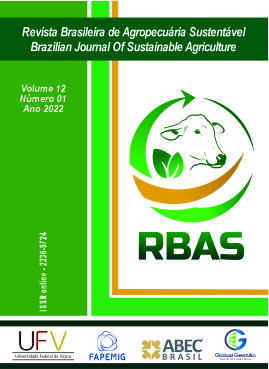CERCOSPORA LEAF SPOT CONTROL OPTIONS IN CHILI PEPPER GROWN IN LOWLAND AREA
DOI:
https://doi.org/10.21206/rbas.v12i1.14754Keywords:
Cercospora capsici, Capsicum frutescens, plant disease control, alternative management.Abstract
The search for a healthier life presupposes, among other conditions, the consumption of good quality products. This finding has led to a growing expansion in the consumption of food produced without the use of pesticides. The effect of alternative products on the control of brown eye spot caused by Cercospora capsici in pepper plants in a lowland area was evaluated. In chili pepper (Capsicum frutescens) plants, sprays were carried out with Viçosa syrup (1.5%), Bordalesa syrup (1.5%), sulfur-calcium syrup (1%), sodium bicarbonate (0.2 M), of neem (5%), raw milk (20%), thiophanate methyl (0.7 g/L) and water (control treatment). The severity and area under the disease progress curve (AACPD), plant crown height and diameters, yield, length, diameter and average fruit weight were determined. Bordalesa syrup at 1.5%, syrup at Viçosa at 1.5%, neem oil at 0.5% and raw milk at 20% are efficient in reducing the severity of cercospora leaf spot in hot peppers cultivated in download area. Bordalesa syrup is more promising for disease control, because in addition to being efficient in reducing the severity of the disease, it is easier to prepare and has a lower relative cost of obtaining. In addition to not causing toxicity to the environment, the applicator and the consumer, the use of this syrup meets the demands of pepper growers who seek to produce pepper not only profitably but also sustainably.
Downloads
Downloads
Published
How to Cite
Issue
Section
License
Copyright (c) 2022 Brazilian Journal of Sustainable Agriculture

This work is licensed under a Creative Commons Attribution-NonCommercial-NoDerivatives 4.0 International License.
1. Proposta de Política para Periódicos de Acesso Livre
Autores que publicam nesta revista concordam com os seguintes termos:
Autores mantém os direitos autorais e concedem à revista o direito de primeira publicação, com o trabalho simultaneamente licenciado sob a Licença Creative Commons Attribution que permite o compartilhamento do trabalho com reconhecimento da autoria e publicação inicial nesta revista.











